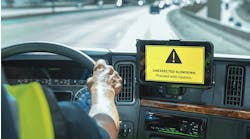Monitoring assets and the drivers who operate them can become a powerful “deflation enabler” for fleets by helping them become more efficient, according to fleet telematics provider Samsara.
Recent data from the transportation technology company backs up this claim. Fleets’ first 12 months using Samsara’s Vehicle Telematics or Video-Based Safety solutions are detailed in a recent report that found these new customers reduced accidents by 47% and idling by 40%. Vehicle utilization also improved by more than 20%.
This added up to tangible operational benefits for Samsara user Artera, a field services company focusing on natural gas and other infrastructure.
“With real-time operational data, we can make smarter business decisions that directly impact our bottom line,” said Farrukh Rafiq, chief procurement officer and VP of fleet for Artera. “For example, we recently sold $10 million of underutilized equipment.
The report was generated from 395 U.S. and Canadian fleet customers with at least 100 active devices who started using the telematics solutions in 2018 or later. In total, these field services and logistics customers accrued 793 million miles last year. The data was filtered through the company's Connected Operations Cloud.
See also: Samsara details how its data is making fleets smarter
“Leaders are under pressure to make every dollar count and only want to invest in technology when it’s a clear win,” said Alexander Stevenson, general manager at Samsara. “Our study points to Samsara as an essential ingredient for smarter operations. We can quickly provide insights that increase productivity, cut costs, and help leaders navigate today’s challenges.”
Samsara noted that customers deploying both the Vehicle Telematics and Video-Based Safety solutions reduced crashes by 63%. An average crash may cost $16,500 to $74,000, and upwards of $500,000 or more if a someone dies, according to NHTSA.
See also: Fleet leaders see more AI technology in their immediate futures
Oil-field logistic provider Chalk Mountain Services used Samsara’s Vehicle Gateways and Video-Based Safety solutions to identify risky behaviors and coach drivers, citing the benefits of the company's AI Dash Cams in particular. As a result, these cameras reduced accident costs by 86% and worker compensation costs by 43%, while driver retention improved by 15% through a data-driven rewards program.
“The biggest contributor to reducing our accident costs was Samsara AI Dash Cams,” said David Serach, director of safety. “Samsara has allowed us to be more proactive in identifying risky behaviors and positively coaching drivers.”
The 40% reduction in idling is significant because fuel accounts for 60% of a fleet’s total operating budget. Monitoring engine idle time with telematics creates driver coaching opportunities for inefficient fuel usage. With diesel at $5 per gallon, a 40% idle reduction equates to saving $2,500 per vehicle per year.
Dohrn Transfer reduced idling and improved fuel efficiency by 50% after adopting Samsara. American Trucking Associations found idling can double engine wear and tear and increase maintenance cost by at least $2,000 per year. The less-than-truckload carrier implemented a fuel coaching and gamification program based on Samsara data that led to smarter idling policies and enabled the fleet to track progress, make changes in real-time based on fuel waste, and reward fuel-conscious drivers.
By using the Samsara Driver App, which uses gamification elements to engage drivers, the fleet also cut down harsh events by 88%.
"Since we started working with Samsara, we have a clearer, more holistic view of safety," Dorhn COO Robert Howard said. "We have more data. We’re able to give feedback to our drivers faster and more accurately. We use that information to make better decisions and to show how much safety is improving at Dohrn."
This article originally appeared on FleetMaintenance, FleetOwner's sister site.






